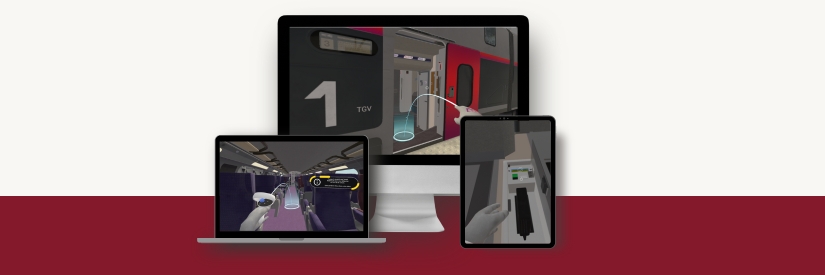The SNCF AR/VR Factory introduced “Secumat” in 2020, a virtual reality training application dedicated to crew on double-decker TGVs. It covers three essential areas of safety: preparation before departure, management of anomalies indicated by codes and the procedures to follow when stopping in the middle of the track. However, with technological developments, an update of Secumat was necessary. A special feature of this update was the need to adapt the application for wireless VR headsets. SNCF mandated the Audace company to accomplish this task.
Device
The Secumat application is a virtual reality (VR) training solution designed for crew on 2-decker TGVs. This application aims to improve the skills and knowledge of employees in terms of pre-departure verification, fault code management and mid-lane stopping.
Content
The Secumat application is made up of three distinct themes, each including several training modules of approximately 10 minutes:
- Pre-departure check: 2 modules
- Fault code management: 6 modules
- Stopping in the middle of the track: 2 modules
The goal is to provide an immersive and interactive experience that allows learners to familiarize themselves with essential procedures in a practical and efficient manner.
Technical solution
Audace has restructured the Secumat application. Instead of a single manager for all scenarios and a monolithic scene for 3D environments, a main manager was created for functions and interactions, with separate scenarios calling on these resources. This restructuring remore adable, scalable and robust code, facilitating testing and maintenance, and optimizes performance for standalone headsets.
Educational Objective
The training aims to improve the skills of crew on 2-decker TGVs in terms of pre-departure checks, fault code management and stopping in the middle of the track. It promotes safe and efficient operations.
Strategic issues
The update of the Secumat application demonstrates SNCF’s commitment to the training of its cabin crew. This results in more secure operations, increased performance and improved customer satisfaction.
Pedagogy
The application incorporates immersive and interactive scenarios, providing learners with the opportunity to practice procedures in a realistic virtual environment. Code restructuring, 3D optimization and interface improvements aim to create a smooth and intuitive learning experience.
Assessment of improvements
- Restructuring the code for optimal organization
- 3D optimization to ensure smooth performance
- Transformation of interfaces for autonomous use in VR
- Interactive tutorial to guide learners
- Improved instructions and docked display for support
- Interactive highlighting with haptic feedback
- Ability to rotate the camera for a better view
- Improved guidance feature for better experience
- Simplified access to menus via the VR interface
- Flexible error handling for a smooth user experience
- Anchoring documents for optimal readability in VR
Test & validation
Audace follows a rigorous testing approach, involving internal and external users to ensure a flawless user experience. Ergonomic methods and tests in real conditions ensure optimal quality of the application.

